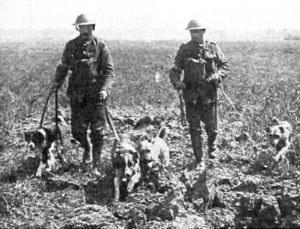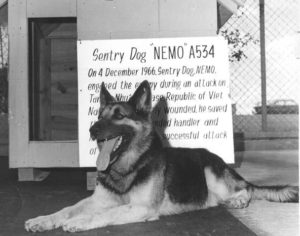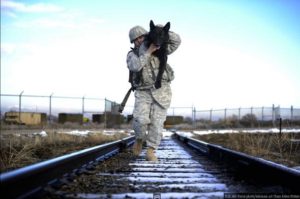
War Dogs at work.
This blog is reprinted from “Memorial Day Tribute to War Dogs,” written by Jason on May 21, 2012. We thought it fitting to honor not just the men and women who have served, but also the many dogs throughout history who have also seen conflict, many who have sacrificed their lives to help their human companions.
History Of War Dogs
You probably haven’t seen much T.V. coverage or read much history on dogs being used in battle, but our canine companions have been instrumental in military victories for thousands of years. Dating back to 18th Century B.C. in the invasion of Egypt by the Hyksos, many dog breeds have been used for different purposes based on their specific abilities. Some of those roles historically have been:
Fighting or Attack Dogs – Larger breeds such as a mastiff or molosser type breeds would be sent into battle ahead of the troops as a first line of attack. It wasn’t uncommon for those dogs to wear armor and large spiked collars.
Logistics & Communication – Dogs have been used in everything from pulling carts, sniffing out the wounded and dragging them to safety, passing messages in bottles back and forth, and in present day collecting intel via video cameras and microphones that are attached to them.
Detection & Tracking – Due to their heightened sense of smell dogs, of course, make excellent trackers and have been used to track fugitives and can even uncover and detect mines.
Sentries – From the beginning, sentry or guard dogs have been used to protect camps and bases and are still used today. It’s estimated that these sentry dogs saved over 10,000 US lives in Vietnam alone.
Current Uses of War Dogs
War dogs are used more today than they ever have been. Training has progressed and their uses have evolved. Presently they have even more roles in our military than ever before. Some of these roles are things you’d expect such as police work, and drug and explosive detection, but they have also been used to intimidate during interrogations. This practice was short lived, however, and has been prohibited.
Famous War Dogs

Chips.
Chips The War Dog: Chips is the most decorated war dog from World War II. Owned by Edward Wren of NY Chips was a German Shepherd-Collie-Siberian Husky Mix. During his service Chip’s handler was Pvt. John P Rowell.
In 1943 during the invasion of Sicily, Chips and his handler got themselves pinned down on the beach by an Italian machine gun team. Breaking free from his handler, Chips proceeded to jump into the pillbox attacking the gunners forcing them out and leading to their surrender.
Sustaining several injuries during this incident, Chips was awarded the Distinguished Service Cross, Silver Star, and Purple Heart; which was later revoked due to the army preventing the commendation of animals. Disney thought Chips deserved some recognition, however, and made a movie about him in 1990. Chips was able to retire and return to the Wren family in 1945.

Nemo.
Nemo The War Dog: Nemo was the first dog to return from the Vietnam war. Nemo was purchased in 1964 and shipped off to Lackland Air Force Base in Texas where he received his serial number A534 which was tattooed in his left ear. Shortly after, he was sent to Vietnam.
Acting as a sentry, Nemo and his handler would patrol an area at the perimeter of the base every night and were the first line of defense against any Vietcong intruders. In early morning hours of December 3rd 1966, 2 Vietcong units made an attempt to infiltrate the base. Thanks to Nemo and the other sentry dogs, security teams were alerted and after 7 hours of hard fighting the invasion was thwarted. Unfortunately, this battle cost three other war dogs and their handlers their lives.
The following night Nemo and his handler were on patrol looking for any stragglers from the previous night’s attempted infiltration. Dduring that patrol, Nemo sensed danger and before his handler could even radio in the threat he was shot in the shoulder and Nemo was shot in the muzzle. The bullet entered under his right eye and exited through his mouth. Not one to quit without a fight, however, Nemo proceeded to attack the 4 Vietcong who had shot him, with no regard for his own life. This gave his handler time to radio in for help.
Once back at base, Nemo received emergency medical care including skin grafts and a tracheotomy but still ended up losing his right eye. These wounds proved to be enough to keep Nemo from returning to duty and he was flown back to Lackland where he spent the rest of his retirement years as an example of a great war dog.

Adopting a war dog.
Adopting A War Dog
Effective November 6th 2000, because of H.R. 5314, civilians are now able to adopt a retiring military working dog. Since that time many war dogs have gone to wonderful and loving forever homes. Once a dog is declared “excess” after their active duty time is up, they can go up for adoption. Prior to this, they are given a complete medical screening and assessment of temperament to make sure the dogs are suited for a civilian home.
Potential owners are also diligently screened to make sure they can handle one of these highly trained war dogs.
About 300 of these dogs are put up for adoption each year but just recently interested adopting parties has dramatically spiked. There is no cost or adoption fee for adopting one of these heroes, but the new family is responsible for travel fees (which can be up to $2000 depending on if they are located oversees). Find out more about adopting a military working dog here.
A Big Thanks To All War Dogs!
With Memorial Day upon us … this year take a little extra time to remember the war dogs who have been instrumental in saving countless lives and making a lasting impact on the handlers they served.
A Salute To Military Working Dogs & Their Handlers
We hope you will enjoy and share this video tribute to Working Dogs and their Handlers.








